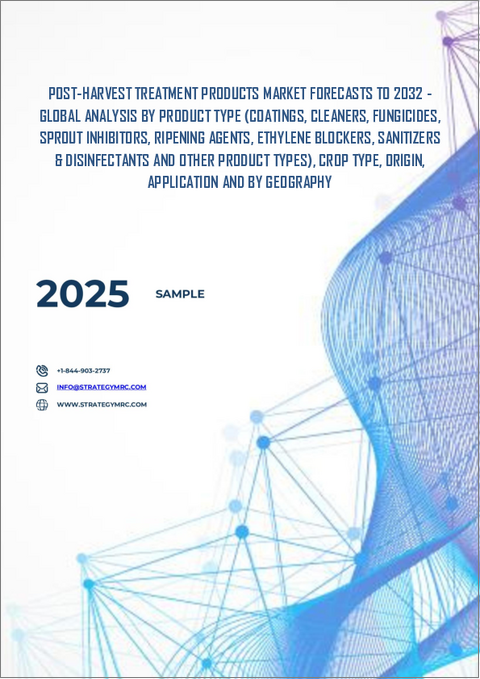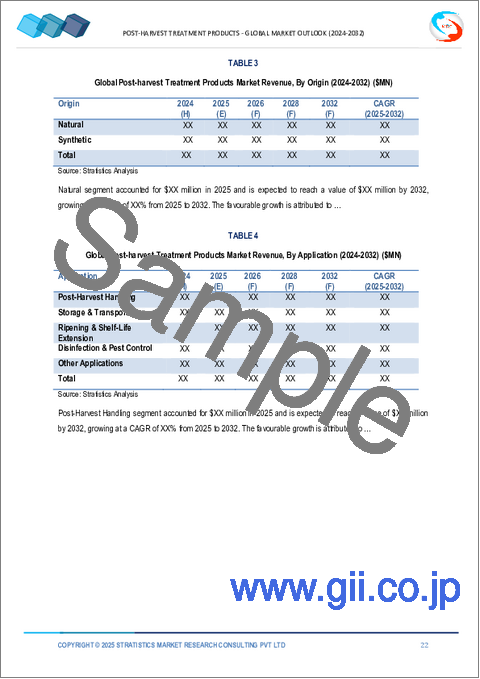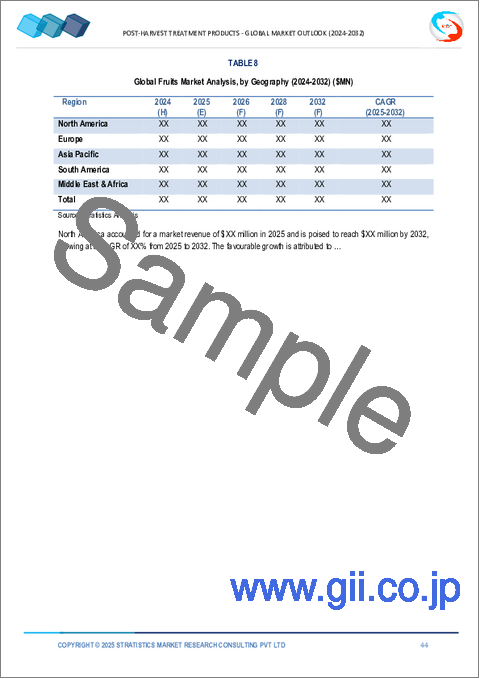|
|
市場調査レポート
商品コード
1734855
ポストハーベスト処理製品市場の2032年までの予測:製品タイプ、作物タイプ、由来、用途、地域別の世界分析Post-harvest Treatment Products Market Forecasts to 2032 - Global Analysis By Product Type, Crop Type, Origin, Application and By Geography |
||||||
カスタマイズ可能
|
|||||||
| ポストハーベスト処理製品市場の2032年までの予測:製品タイプ、作物タイプ、由来、用途、地域別の世界分析 |
|
出版日: 2025年05月03日
発行: Stratistics Market Research Consulting
ページ情報: 英文 200+ Pages
納期: 2~3営業日
|
全表示
- 概要
- 図表
- 目次
Stratistics MRCによると、ポストハーベスト処理製品の世界市場は2025年に25億2,000万米ドルを占め、予測期間中にCAGR 7.3%で成長し、2032年には41億2,000万米ドルに達すると予測されています。
ポストハーベスト処理製品は、ポストハーベストの農産物に適用される物質または技術であり、品質を維持し、貯蔵期間を延長し、腐敗を低減します。これらの処理には、殺菌剤、コーティング剤、除菌剤、熟成剤などが含まれ、保管や輸送中の鮮度保持に役立ちます。一般的に果物、野菜、穀物に使用され、ポストハーベスト・ロスを最小限に抑え、市場性を向上させ、農場から消費者までのサプライ・チェーン全体で食品の安全性を確保する上で重要な役割を果たしています。
米国食糧農業機関によると、世界全体の年間食品ロス・廃棄量は、穀物で約30%、根菜類、果物、野菜で40~50%、油糧種子、食肉、乳製品で20%、水産物で35%以上となっています。
生鮮農産物の輸出増加
新鮮な果物や野菜に対する世界の需要は、特に新興経済諸国からの輸出増加につながっています。ロジスティクスと輸送の進歩により、生産者は国境を越えて生鮮品を効率的に出荷できるようになりました。政府や貿易団体は輸出を促進する政策を実施し、農家の収入源を増やしています。近代的な保存技術の採用により保存期間が延長され、より高品質な農産物が国際市場に届くようになります。持続可能な包装や加工方法への投資は、輸出品の魅力をさらに高める。
小規模農家の意識が低い
体系的な研修プログラムがないため、改良された保存技術を導入することができないです。十分な知識がないため、農家は農産物の品質を最適化できない伝統的な手法に頼り続けています。さらに、財政的な制約が、近代的なポストハーベスト対策への投資を妨げています。この意識のギャップを埋め、知識の公平な分配を確保するためには、政府と業界主導の取り組みが不可欠です。アウトリーチ・プログラムを拡大することで、小規模農家が技術の進歩から利益を得られるようにすることができます。
ポストハーベスト技術の進歩
食用コーティング、管理された雰囲気貯蔵、精密乾燥技術などの革新は、農産物の日持ちを向上させる。保存方法の向上により廃棄物が削減され、生産者や輸出業者の利益率が向上します。ポストハーベスト・モニタリングにおけるAIとIoTの統合は、保存状態に関するリアルタイムの洞察を提供します。これらの進歩に投資する企業は、農産物の最適な鮮度を確保することで、競争力を得ることができます。研究開発の継続は、ポストハーベスト・プロセスの効率性と持続可能性に革命をもたらすことを約束します。
コールドチェーン・インフラの不足
不十分な低温貯蔵施設と輸送施設は、ポストハーベスト処理の成功にとって大きな課題となります。多くの地域で温度管理が安定せず、腐敗率の上昇につながっています。インフラコストが高いため、大規模なコールドチェーン・ネットワークへの投資が進まないです。中小企業は手頃な価格の冷蔵ロジスティクスへのアクセスに苦労しており、世界市場での競争力を低下させています。このギャップに対処するには、政府、民間団体、技術プロバイダーの協力が必要です。
COVID-19の影響
COVID-19パンデミックは、サプライチェーンに影響を与え、貿易活動を制限することにより、ポストハーベスト処理業界を混乱させました。移動の制限により、輸送の遅れによる食品の腐敗が増加しました。しかし、この危機はポストハーベスト管理のためのデジタル監視ツールの導入を加速させました。生産者はリスクを軽減し効率を高めるため、自動化や遠隔追跡ソリューションに目を向けた。パンデミック後は、弾力的で適応性のある処理技術に焦点が移っています。
予測期間中はコーティング部門が最大になる見込み
コーティング分野は、生鮮品の賞味期限延長に重要な役割を果たすことから、予測期間中に最大の市場シェアを占めると予想されます。食用コーティングや保護フィルムは、保湿、酸化の抑制、微生物汚染の防止に役立ちます。天然素材や生分解性コーティングへの嗜好の高まりが、世界市場での採用を促進しています。
ポストハーベスト処理分野は予測期間中最も高いCAGRが見込まれる
予測期間中、加工とロジスティクスの改善により、ポストハーベスト処理分野が最も高い成長率を示すと予測されます。自動化された選別、等級付け、保管ソリューションなどの技術は、効率を最適化し、ロスを削減します。新鮮で加工度の低い食品に対する消費者の嗜好の高まりが、高度な処理方法の必要性を高めています。国際貿易における鮮度保持に対する需要は、ポストハーベスト処理技術の進化を促しています。
最大のシェアを占める地域:
予測期間中、アジア太平洋地域は、その広範な農業生産高と輸出能力により、最大の市場シェアを占めると予想されます。政府の強力なイニシアチブがポストハーベスト処理技術の進歩を支えています。中国、インド、日本のような国々が保存方法の革新を推進しています。都市化の進展と消費者の嗜好の変化が、高品質の生鮮農産物への需要に拍車をかけています。主要業界プレイヤーの存在が、ポストハーベスト処理市場における同地域のリーダーシップに寄与しています。
CAGRが最も高い地域:
予測期間中、北米地域が最も高いCAGRを示すと予測されるが、これは高度なポストハーベスト処理ソリューションへの投資が増加しているためです。この地域の強力な研究開発エコシステムは、保存技術の革新を促進しています。食品廃棄物に対する意識の高まりと持続可能性への懸念が、新しい処理方法の採用を加速させています。政府が支援するイニシアティブは、インフラの改善とコールドチェーンの拡大を支援します。
無料のカスタマイズサービス:
本レポートをご購読のお客様には、以下の無料カスタマイズオプションのいずれかをご利用いただけます:
- 企業プロファイル
- 追加市場プレーヤーの包括的プロファイリング(3社まで)
- 主要企業のSWOT分析(3社まで)
- 地域セグメンテーション
- 顧客の関心に応じた主要国の市場推計・予測・CAGR(注:フィージビリティチェックによる)
- 競合ベンチマーキング
- 製品ポートフォリオ、地理的プレゼンス、戦略的提携に基づく主要企業のベンチマーキング
目次
第1章 エグゼクティブサマリー
第2章 序文
- 概要
- ステークホルダー
- 調査範囲
- 調査手法
- データマイニング
- データ分析
- データ検証
- 調査アプローチ
- 調査資料
- 1次調査資料
- 2次調査情報源
- 前提条件
第3章 市場動向分析
- 促進要因
- 抑制要因
- 機会
- 脅威
- 製品分析
- 用途分析
- 新興市場
- COVID-19の影響
第4章 ポーターのファイブフォース分析
- 供給企業の交渉力
- 買い手の交渉力
- 代替品の脅威
- 新規参入業者の脅威
- 競争企業間の敵対関係
第5章 世界のポストハーベスト処理製品市場:製品タイプ別
- コーティング
- 食用コーティング
- 合成コーティング
- クリーナー
- 塩素系
- オゾンベース
- 過酸化水素ベース
- 殺菌剤
- 化学殺菌剤
- バイオ殺菌剤
- 発芽抑制剤
- 熟成剤
- エチレンブロッカー
- 消毒剤
- その他の製品タイプ
第6章 世界のポストハーベスト処理製品市場:作物別
- 果物
- 野菜
- 穀物
- 花と観賞植物
- その他の作物タイプ
第7章 世界のポストハーベスト処理製品市場:由来別
- 天然
- 合成
第8章 世界のポストハーベスト処理製品市場:用途別
- ポストハーベストの処理
- 保管と輸送
- 熟成と賞味期限の延長
- 消毒と害虫駆除
- その他の用途
第9章 世界のポストハーベスト処理製品市場:地域別
- 北米
- 米国
- カナダ
- メキシコ
- 欧州
- ドイツ
- 英国
- イタリア
- フランス
- スペイン
- その他欧州
- アジア太平洋
- 日本
- 中国
- インド
- オーストラリア
- ニュージーランド
- 韓国
- その他アジア太平洋地域
- 南米
- アルゼンチン
- ブラジル
- チリ
- その他南米
- 中東・アフリカ
- サウジアラビア
- アラブ首長国連邦
- カタール
- 南アフリカ
- その他中東とアフリカ
第10章 主な発展
- 契約、パートナーシップ、コラボレーション、ジョイントベンチャー
- 買収と合併
- 新製品発売
- 事業拡大
- その他の主要戦略
第11章 企業プロファイリング
- AgroFresh
- BASF
- Bayer AG
- Syngenta Crop Protection AG
- JBT Corporation
- Nufarm
- Pace International LLC
- Xeda International S.A.S.
- DECCO(part of UPL)
- Citrosol S.A.
- Hazel Technologies, Inc.
- Lytone Enterprise, Inc.
- Shandong Aoweite Biotechnology Co., Ltd.
- Fine Chemicals Inc.
- Futureco Bioscience S.A.
List of Tables
- Table 1 Global Post-harvest Treatment Products Market Outlook, By Region (2024-2032) ($MN)
- Table 2 Global Post-harvest Treatment Products Market Outlook, By Product Type (2024-2032) ($MN)
- Table 3 Global Post-harvest Treatment Products Market Outlook, By Coatings (2024-2032) ($MN)
- Table 4 Global Post-harvest Treatment Products Market Outlook, By Edible coatings (2024-2032) ($MN)
- Table 5 Global Post-harvest Treatment Products Market Outlook, By Synthetic coatings (2024-2032) ($MN)
- Table 6 Global Post-harvest Treatment Products Market Outlook, By Cleaners (2024-2032) ($MN)
- Table 7 Global Post-harvest Treatment Products Market Outlook, By Chlorine-based (2024-2032) ($MN)
- Table 8 Global Post-harvest Treatment Products Market Outlook, By Ozone-based (2024-2032) ($MN)
- Table 9 Global Post-harvest Treatment Products Market Outlook, By Hydrogen peroxide-based (2024-2032) ($MN)
- Table 10 Global Post-harvest Treatment Products Market Outlook, By Fungicides (2024-2032) ($MN)
- Table 11 Global Post-harvest Treatment Products Market Outlook, By Chemical fungicides (2024-2032) ($MN)
- Table 12 Global Post-harvest Treatment Products Market Outlook, By Biofungicides (2024-2032) ($MN)
- Table 13 Global Post-harvest Treatment Products Market Outlook, By Sprout Inhibitors (2024-2032) ($MN)
- Table 14 Global Post-harvest Treatment Products Market Outlook, By Ripening Agents (2024-2032) ($MN)
- Table 15 Global Post-harvest Treatment Products Market Outlook, By Ethylene Blockers (2024-2032) ($MN)
- Table 16 Global Post-harvest Treatment Products Market Outlook, By Sanitizers & Disinfectants (2024-2032) ($MN)
- Table 17 Global Post-harvest Treatment Products Market Outlook, By Other Product Types (2024-2032) ($MN)
- Table 18 Global Post-harvest Treatment Products Market Outlook, By Crop Type (2024-2032) ($MN)
- Table 19 Global Post-harvest Treatment Products Market Outlook, By Fruits (2024-2032) ($MN)
- Table 20 Global Post-harvest Treatment Products Market Outlook, By Vegetables (2024-2032) ($MN)
- Table 21 Global Post-harvest Treatment Products Market Outlook, By Grains & Cereals (2024-2032) ($MN)
- Table 22 Global Post-harvest Treatment Products Market Outlook, By Flowers & Ornamentals (2024-2032) ($MN)
- Table 23 Global Post-harvest Treatment Products Market Outlook, By Other Crop Types (2024-2032) ($MN)
- Table 24 Global Post-harvest Treatment Products Market Outlook, By Origin (2024-2032) ($MN)
- Table 25 Global Post-harvest Treatment Products Market Outlook, By Natural (2024-2032) ($MN)
- Table 26 Global Post-harvest Treatment Products Market Outlook, By Synthetic (2024-2032) ($MN)
- Table 27 Global Post-harvest Treatment Products Market Outlook, By Application (2024-2032) ($MN)
- Table 28 Global Post-harvest Treatment Products Market Outlook, By Post-Harvest Handling (2024-2032) ($MN)
- Table 29 Global Post-harvest Treatment Products Market Outlook, By Storage & Transportation (2024-2032) ($MN)
- Table 30 Global Post-harvest Treatment Products Market Outlook, By Ripening & Shelf-Life Extension (2024-2032) ($MN)
- Table 31 Global Post-harvest Treatment Products Market Outlook, By Disinfection & Pest Control (2024-2032) ($MN)
- Table 32 Global Post-harvest Treatment Products Market Outlook, By Other Applications (2024-2032) ($MN)
Note: Tables for North America, Europe, APAC, South America, and Middle East & Africa Regions are also represented in the same manner as above.
According to Stratistics MRC, the Global Post-harvest Treatment Products Market is accounted for $2.52 billion in 2025 and is expected to reach $4.12 billion by 2032 growing at a CAGR of 7.3% during the forecast period. Post-harvest treatment products are substances or technologies applied to agricultural produce after harvesting to maintain quality, extend shelf life, and reduce spoilage. These treatments include fungicides, coatings, sanitizers, and ripening agents, helping preserve freshness during storage and transport. Commonly used for fruits, vegetables, and grains, they play a vital role in minimizing post-harvest losses, improving marketability, and ensuring food safety across the supply chain from farm to consumer.
According to the United States Food and Agriculture Organization, global quantitative food losses and waste each year are roughly 30% for cereals, 40-50 percent for root crops, fruits, and vegetables, 20% for oilseeds, meat, and dairy, and more than 35% for seafood.
Market Dynamics:
Driver:
Increasing export of perishable produce
The global demand for fresh fruits and vegetables has led to a rise in exports, particularly from developing economies. Advancements in logistics and transportation allow producers to ship perishable goods across borders efficiently. Governments and trade organizations are implementing policies that promote exports, boosting revenue streams for farmers. The adoption of modern preservation techniques extends shelf life, ensuring higher-quality produce reaches international markets. Investments in sustainable packaging and processing methods further enhance the appeal of exported goods.
Restraint:
Limited awareness among small-scale farmers
The absence of structured training programs prevents them from adopting improved preservation techniques. Without adequate knowledge, farmers continue to rely on traditional practices that do not optimize produce quality. Additionally, financial constraints hinder investments in modern post-harvest solutions. Government and industry-led initiatives are essential in bridging this awareness gap and ensuring equitable knowledge distribution. Expanding outreach programs can empower small-scale farmers to benefit from technological advancements.
Opportunity:
Advancements in post-harvest technologies
Innovations such as edible coatings, controlled atmosphere storage, and precision drying techniques improve produce longevity. Enhanced preservation methods reduce waste, resulting in higher profit margins for producers and exporters. The integration of AI and IoT in post-harvest monitoring offers real-time insights into storage conditions. Companies investing in these advancements gain a competitive edge by ensuring optimal produce freshness. Continued research and development promise to revolutionize the efficiency and sustainability of post-harvest processes.
Threat:
Lack of cold chain infrastructure
Inadequate cold storage and transportation facilities pose a significant challenge to post-harvest treatment success. Many regions suffer from inconsistent temperature control, leading to increased spoilage rates. High infrastructure costs deter investment in large-scale cold chain networks. Small and medium-sized enterprises struggle to access affordable refrigerated logistics, reducing their competitiveness in global markets. Addressing this gap requires collaboration between governments, private entities, and technology providers.
Covid-19 Impact
The COVID-19 pandemic disrupted the post-harvest treatment industry by affecting supply chains and limiting trade activities. Movement restrictions led to increased food spoilage due to delays in transportation. However, the crisis accelerated the adoption of digital monitoring tools for post-harvest management. Producers turned to automation and remote tracking solutions to mitigate risks and enhance efficiency. Post-pandemic, the focus has shifted toward resilient and adaptive treatment technologies.
The coatings segment is expected to be the largest during the forecast period
The coatings segment is expected to account for the largest market share during the forecast period, due to its significant role in extending the shelf life of perishable goods. Edible coatings and protective films help retain moisture, reduce oxidation, and prevent microbial contamination. The increasing preference for natural and biodegradable coatings enhances their adoption across global markets.
The post-harvest handling segment is expected to have the highest CAGR during the forecast period
Over the forecast period, the post-harvest handling segment is predicted to witness the highest growth rate, due to improvements in processing and logistics. Technologies such as automated sorting, grading, and storage solutions optimize efficiency and reduce losses. The rising consumer preference for fresh and minimally processed foods amplifies the need for sophisticated handling methods. The demand for extended freshness in international trade is driving the evolution of post-harvest handling techniques.
Region with largest share:
During the forecast period, the Asia Pacific region is expected to hold the largest market share due to its extensive agricultural output and export capabilities. Strong governmental initiatives support advancements in post-harvest treatment technologies. Countries like China, India, and Japan are driving innovations in preservation methods. Increasing urbanization and changing consumer preferences fuel demand for high-quality fresh produce. The presence of key industry players contributes to the region's leadership in the post-harvest treatment market.
Region with highest CAGR:
Over the forecast period, the North America region is anticipated to exhibit the highest CAGR, owing to growing investments in advanced post-harvest treatment solutions. The region's strong research and development ecosystem fosters innovation in preservation technologies. Increasing awareness of food wastage and sustainability concerns accelerates the adoption of new treatment methods. Government-backed initiatives support infrastructure improvements and cold chain expansions.
Key players in the market
Some of the key players profiled in the Post-harvest Treatment Products Market include AgroFresh, BASF, Bayer AG, Syngenta Crop Protection AG, JBT Corporation, Nufarm, Pace International LLC, Xeda International S.A.S., DECCO (part of UPL), Citrosol S.A., Hazel Technologies, Inc., Lytone Enterprise, Inc., Shandong Aoweite Biotechnology Co., Ltd., Fine Chemicals Inc., and Futureco Bioscience S.A.
Key Developments:
In April 2025, BASF and Hagihara Industries, Inc., have joined forces to develop highly durable polyolefin yarns for artificial turf used in sports arenas, including football stadiums, baseball fields, and tennis courts. After three years of collaborative research and development, the two companies have created an advanced formulation with a series of Tinuvin(R) grades that significantly enhances the durability of synthetic grass.
In February 2025, Syngenta and Ceres Biotics sign agreement to bring innovative biological solution to farmers globally. VIXERAN(R) enables farmers to optimize nitrogen fertilizer use and transition to more sustainable on-farm practices.
Product Types Covered:
- Coatings
- Cleaners
- Fungicides
- Sprout Inhibitors
- Ripening Agents
- Ethylene Blockers
- Sanitizers & Disinfectants
- Other Product Types
Crop Types Covered:
- Fruits
- Vegetables
- Grains & Cereals
- Flowers & Ornamentals
- Other Crop Types
Origins Covered:
- Natural
- Synthetic
Applications Covered:
- Post-Harvest Handling
- Storage & Transportation
- Ripening & Shelf-Life Extension
- Disinfection & Pest Control
- Other Applications
Regions Covered:
- North America
- US
- Canada
- Mexico
- Europe
- Germany
- UK
- Italy
- France
- Spain
- Rest of Europe
- Asia Pacific
- Japan
- China
- India
- Australia
- New Zealand
- South Korea
- Rest of Asia Pacific
- South America
- Argentina
- Brazil
- Chile
- Rest of South America
- Middle East & Africa
- Saudi Arabia
- UAE
- Qatar
- South Africa
- Rest of Middle East & Africa
What our report offers:
- Market share assessments for the regional and country-level segments
- Strategic recommendations for the new entrants
- Covers Market data for the years 2022, 2023, 2024, 2026, and 2030
- Market Trends (Drivers, Constraints, Opportunities, Threats, Challenges, Investment Opportunities, and recommendations)
- Strategic recommendations in key business segments based on the market estimations
- Competitive landscaping mapping the key common trends
- Company profiling with detailed strategies, financials, and recent developments
- Supply chain trends mapping the latest technological advancements
Free Customization Offerings:
All the customers of this report will be entitled to receive one of the following free customization options:
- Company Profiling
- Comprehensive profiling of additional market players (up to 3)
- SWOT Analysis of key players (up to 3)
- Regional Segmentation
- Market estimations, Forecasts and CAGR of any prominent country as per the client's interest (Note: Depends on feasibility check)
- Competitive Benchmarking
- Benchmarking of key players based on product portfolio, geographical presence, and strategic alliances
Table of Contents
1 Executive Summary
2 Preface
- 2.1 Abstract
- 2.2 Stake Holders
- 2.3 Research Scope
- 2.4 Research Methodology
- 2.4.1 Data Mining
- 2.4.2 Data Analysis
- 2.4.3 Data Validation
- 2.4.4 Research Approach
- 2.5 Research Sources
- 2.5.1 Primary Research Sources
- 2.5.2 Secondary Research Sources
- 2.5.3 Assumptions
3 Market Trend Analysis
- 3.1 Introduction
- 3.2 Drivers
- 3.3 Restraints
- 3.4 Opportunities
- 3.5 Threats
- 3.6 Product Analysis
- 3.7 Application Analysis
- 3.8 Emerging Markets
- 3.9 Impact of Covid-19
4 Porters Five Force Analysis
- 4.1 Bargaining power of suppliers
- 4.2 Bargaining power of buyers
- 4.3 Threat of substitutes
- 4.4 Threat of new entrants
- 4.5 Competitive rivalry
5 Global Post-harvest Treatment Products Market, By Product Type
- 5.1 Introduction
- 5.2 Coatings
- 5.2.1 Edible coatings
- 5.2.2 Synthetic coatings
- 5.3 Cleaners
- 5.3.1 Chlorine-based
- 5.3.2 Ozone-based
- 5.3.3 Hydrogen peroxide-based
- 5.4 Fungicides
- 5.4.1 Chemical fungicides
- 5.4.2 Biofungicides
- 5.5 Sprout Inhibitors
- 5.6 Ripening Agents
- 5.7 Ethylene Blockers
- 5.8 Sanitizers & Disinfectants
- 5.9 Other Product Types
6 Global Post-harvest Treatment Products Market, By Crop Type
- 6.1 Introduction
- 6.2 Fruits
- 6.3 Vegetables
- 6.4 Grains & Cereals
- 6.5 Flowers & Ornamentals
- 6.6 Other Crop Types
7 Global Post-harvest Treatment Products Market, By Origin
- 7.1 Introduction
- 7.2 Natural
- 7.3 Synthetic
8 Global Post-harvest Treatment Products Market, By Application
- 8.1 Introduction
- 8.2 Post-Harvest Handling
- 8.3 Storage & Transportation
- 8.4 Ripening & Shelf-Life Extension
- 8.5 Disinfection & Pest Control
- 8.6 Other Applications
9 Global Post-harvest Treatment Products Market, By Geography
- 9.1 Introduction
- 9.2 North America
- 9.2.1 US
- 9.2.2 Canada
- 9.2.3 Mexico
- 9.3 Europe
- 9.3.1 Germany
- 9.3.2 UK
- 9.3.3 Italy
- 9.3.4 France
- 9.3.5 Spain
- 9.3.6 Rest of Europe
- 9.4 Asia Pacific
- 9.4.1 Japan
- 9.4.2 China
- 9.4.3 India
- 9.4.4 Australia
- 9.4.5 New Zealand
- 9.4.6 South Korea
- 9.4.7 Rest of Asia Pacific
- 9.5 South America
- 9.5.1 Argentina
- 9.5.2 Brazil
- 9.5.3 Chile
- 9.5.4 Rest of South America
- 9.6 Middle East & Africa
- 9.6.1 Saudi Arabia
- 9.6.2 UAE
- 9.6.3 Qatar
- 9.6.4 South Africa
- 9.6.5 Rest of Middle East & Africa
10 Key Developments
- 10.1 Agreements, Partnerships, Collaborations and Joint Ventures
- 10.2 Acquisitions & Mergers
- 10.3 New Product Launch
- 10.4 Expansions
- 10.5 Other Key Strategies
11 Company Profiling
- 11.1 AgroFresh
- 11.2 BASF
- 11.3 Bayer AG
- 11.4 Syngenta Crop Protection AG
- 11.5 JBT Corporation
- 11.6 Nufarm
- 11.7 Pace International LLC
- 11.8 Xeda International S.A.S.
- 11.9 DECCO (part of UPL)
- 11.10 Citrosol S.A.
- 11.11 Hazel Technologies, Inc.
- 11.12 Lytone Enterprise, Inc.
- 11.13 Shandong Aoweite Biotechnology Co., Ltd.
- 11.14 Fine Chemicals Inc.
- 11.15 Futureco Bioscience S.A.





